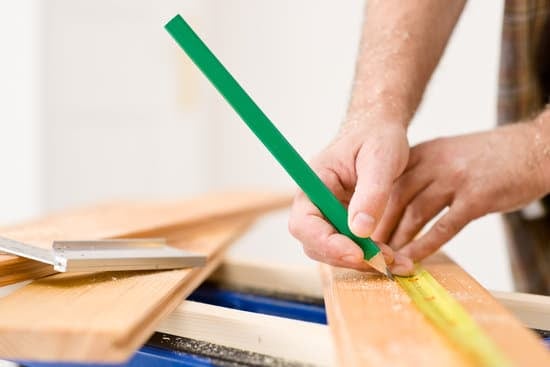Are you wondering, “Can you report home improvements on your taxes?” The answer is yes, but there are specific guidelines and requirements to follow. In this article, we will explore the basics of home improvements and taxes, including what improvements are eligible for reporting, deductible expenses, the importance of record-keeping, potential tax credits, reporting procedures, and common mistakes to avoid.
When it comes to home improvement projects, many homeowners are interested in maximizing their tax benefits. By understanding the rules and regulations surrounding home improvements and taxes, you can potentially save money and maximize your return.
In the following sections, we will delve into the specific details of eligible and ineligible home improvements, deductible expenses, proper record-keeping practices, potential tax credits that may be available to you, reporting procedures for including home improvements on your taxes, as well as common mistakes to watch out for. Understanding these key elements will help ensure that you make the most of your tax benefits when it comes to home improvements.
Eligible Home Improvements
When it comes to reporting home improvements on your taxes, it’s important to understand which improvements are eligible for tax benefits. This can help you maximize your potential tax savings and ensure that you are accurately reporting your expenses. Eligible home improvements include any upgrades or renovations that increase the value of your home, improve its functionality, or make it more energy efficient.
Energy-Efficient Upgrades
One category of eligible home improvements that can be reported on your taxes includes energy-efficient upgrades. This can include installing solar panels, energy-efficient windows and doors, insulation, and other green energy technologies. These types of improvements not only benefit the environment but also provide potential tax credits for homeowners.
Medical Necessity Modifications
Another category of eligible home improvements is modifications made for medical necessity. This includes adding ramps, handrails, or widening doorways to accommodate individuals with disabilities or medical conditions. While these modifications may not directly increase the value of your home, they can still be reported on your taxes as eligible expenses.
Home Office Improvements
For those who use part of their home for business purposes, certain home office improvements may also be eligible for tax reporting. This could include renovations to create a dedicated workspace, upgrades to improve internet connectivity or security systems, and other improvements related to operating a business from a home office.
Understanding which home improvements are eligible for tax reporting can help you take advantage of potential tax benefits while ensuring compliance with IRS regulations. It’s important to keep proper documentation and seek professional advice if necessary to accurately report these expenses on your taxes.
Ineligible Home Improvements
When it comes to home improvements, not all expenses can be reported on your taxes for a deduction or credit. Understanding which home improvements are ineligible for tax reporting is important to avoid potential issues with the IRS. Here are some examples of home improvements that cannot be reported on your taxes:
- Normal repairs and maintenance: Expenses for routine repairs and maintenance, such as fixing a leaky faucet or replacing a broken window, cannot be reported on your taxes.
- Cosmetic upgrades: Costs for purely cosmetic upgrades, such as painting the walls or installing new carpeting, are not eligible for tax reporting.
- Landscaping and outdoor amenities: Expenses related to landscaping, gardening, or installing outdoor amenities like a swimming pool or a new deck generally cannot be reported for tax benefits.
It’s important to note that while these types of home improvements may not qualify for tax reporting, they can still add value to your property and enhance your overall living experience. However, when it comes to seeking tax benefits, it’s essential to focus on eligible home improvements that meet the criteria set by the IRS.
In addition to the above examples, expenses related to any improvements made to rental properties or second homes also typically do not qualify for tax reporting. It’s crucial to consult with a qualified tax professional if you have any questions about whether specific home improvement expenses can be reported on your taxes.
Deductible Expenses
When it comes to reporting home improvements on your taxes, it’s important to understand which costs can be deducted. Knowing which expenses are deductible can help you maximize your tax benefits and potentially save you money. Here are some deductible expenses that you can report on your taxes:
- Materials: The cost of materials for home improvements, such as lumber, paint, or fixtures, can typically be deducted.
- Labor: If you hire professionals to perform the home improvements, the labor costs may also be deductible.
- Permits and Fees: Any permits or fees required for the home improvements can often be included as deductible expenses.
It’s important to keep in mind that not all home improvement costs are deductible. For example, general maintenance and repairs cannot be reported on your taxes. Additionally, any improvements that add value to your property but do not directly contribute to its maintenance or repair may not be eligible for deduction.
Properly understanding which costs are deductible when reporting home improvements on your taxes can ultimately provide you with potential tax savings. Keeping detailed records of your expenses and consulting with a tax professional can also ensure that you accurately report these deductions and avoid any mistakes that could lead to penalties or audits.
Record Keeping
Proper documentation is essential when it comes to reporting home improvements on your taxes. Without the right paperwork, you may not be able to take advantage of the tax benefits that come with these improvements. Keeping detailed records can also help in case you are audited by the IRS.
When it comes to eligible home improvements that can be reported on your taxes, having proper documentation is crucial. This includes receipts for materials and labor, permits, and any other relevant documents that show the costs and nature of the improvements. Additionally, keeping track of before-and-after photos can also provide evidence of the work done.
Ineligible home improvements, on the other hand, should also be documented properly for tax purposes. While you cannot report certain home improvements like aesthetic upgrades or maintenance costs, having records of these expenses can still help in proving which expenses are eligible for tax deductions or credits. Whether an improvement is eligible or not, maintaining accurate records will ensure that you are prepared to report on your taxes effectively.
| Documentation | Importance |
|---|---|
| Receipts for materials and labor | Show the costs and nature of the improvements |
| Permits | Evidence of legal compliance for the improvement |
| Before-and-after photos | Evidence of work done |
| Aesthetic upgrades or maintenance costs | Cannot be reported but still beneficial for record-keeping purposes. |
Tax Credits
Homeowners who have made improvements to their homes may be eligible for tax credits, which can help reduce their tax liability. There are several potential tax credits available for home improvements, including the Residential Energy Efficient Property Credit and the Nonbusiness Energy Property Credit.
These credits can offset the cost of making energy-efficient improvements to your home, such as installing solar panels, geothermal heat pumps, or energy-efficient windows and doors. It’s important to note that these credits are subject to certain eligibility requirements and limitations, so it’s essential to carefully review the IRS guidelines to determine if you qualify.
In addition to energy-efficient improvements, homeowners may also be able to claim a tax credit for certain medical expenses related to home modifications. For example, if you have made renovations to your home to accommodate a disability or medical condition, you may be eligible for the Home Accessibility Tax Credit.
This credit can help offset the costs of installing ramps, handrails, or other modifications that improve accessibility and mobility within your home. Again, it’s crucial to keep detailed records and documentation of these expenses in order to support your claim for the tax credit.
When exploring potential tax credits for home improvements, it’s important for homeowners to consult with a qualified tax professional or financial advisor. They can provide guidance on the eligibility requirements and limitations of each credit, as well as help ensure that you are accurately reporting your eligible expenses on your tax return. By taking advantage of these potential credits, homeowners can maximize their tax benefits while also improving the value and energy efficiency of their homes.
Reporting Home Improvements
Understanding the Forms
When reporting home improvements on your taxes, it’s essential to use the correct forms. For most home improvement expenses, you’ll need to use Form 8936 for residential energy credits or Form 5695 for other qualified residential energy efficiency improvements. If you’ve made significant renovations or additions, such as a new bedroom or bathroom, you may need to use Form 8829 for business use of your home if applicable.
Itemizing Deductions
In order to report home improvements on your taxes, you will likely need to itemize your deductions rather than taking the standard deduction. This means keeping track of all eligible expenses and including them on Schedule A of Form 1040. It’s important to note that only expenses that exceed a certain threshold percentage of your adjusted gross income can be deducted, so be sure to keep accurate records and consult with a tax professional if needed.
Consulting With a Tax Professional
Navigating the complexities of reporting home improvements on your taxes can be challenging, especially if you’re not familiar with tax laws and regulations. Consulting with a tax professional is highly recommended if you have questions or concerns about reporting home improvements. They can provide guidance on which expenses are eligible for deduction, help ensure that you’re using the correct forms, and offer advice on maximizing your tax benefits for home improvements.
Common Mistakes to Avoid
When it comes to reporting home improvements on your taxes, there are some common mistakes that you’ll want to avoid in order to maximize your tax benefits. One of the biggest pitfalls to watch out for is including ineligible home improvements in your report. Not all home improvements are eligible for tax deductions or credits, so it’s important to understand which expenses qualify and which do not.
Another mistake to avoid is failing to keep proper documentation of your home improvement expenses. Without proper records, you may struggle to provide evidence of the costs you’ve incurred, which can result in being unable to claim the deductions or credits you’re entitled to. It’s essential to keep receipts, invoices, and any other relevant documents in a safe place for at least three years after filing your taxes.
Additionally, one common mistake that homeowners make when reporting home improvements on their taxes is incorrectly calculating their deductible expenses. It’s important to know which costs can be deducted, such as those related to energy-efficient upgrades or medically necessary modifications for disabled individuals. Working with a tax professional can help ensure that you accurately calculate and report your deductible expenses.
Conclusion
In conclusion, reporting home improvements on your taxes can be a valuable way to maximize your tax benefits. By understanding which home improvements are eligible for reporting, keeping proper documentation, and avoiding common mistakes, homeowners can potentially save money on their tax bill. It is important to consult with a tax professional or accountant to ensure that you are accurately reporting your home improvements and taking advantage of any potential tax credits.
Taking the time to review deductible expenses and exploring potential tax credits for home improvements can lead to significant savings. Whether it’s energy-efficient upgrades, adding a new room, or renovating your kitchen or bathroom, being aware of what you can report on your taxes is crucial. Additionally, maintaining thorough records of all costs and expenses related to your home improvements will help support any claims made on your tax return.
In summary, while reporting home improvements on your taxes can result in potential financial benefits, it is essential to approach this process carefully and accurately. With the right knowledge and guidance from a tax professional, homeowners can take full advantage of available deductions and credits while ensuring compliance with tax laws and regulations.
Frequently Asked Questions
Can I Claim Home Improvements on My Tax Return?
You generally can’t claim home improvements on your tax return. However, if the improvements qualify as medical expenses, or if you use part of your home for business, you may be able to get some tax benefits.
Is Painting a House Tax Deductible?
Painting a house is usually not tax deductible as a home improvement expense. Generally, painting is considered a maintenance cost rather than a capital improvement. However, if it’s part of a larger renovation project, it might be eligible for a tax deduction.
How Do I Prove Home Improvements Without Receipts?
Proving home improvements without receipts can be challenging, but it’s not impossible. You can use credit card statements, bank records, or contracts with contractors as evidence of the work done. It’s also important to keep detailed records and documentation of any improvements made to your home.

I’m thrilled to have you here as a part of the Remodeling Top community. This is where my journey as an architect and remodeling enthusiast intersects with your passion for transforming houses into dream homes.





